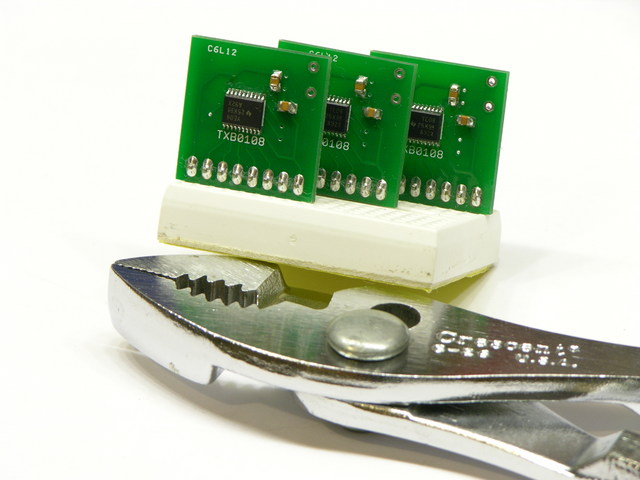I wouldn’t want to do it for a living, but it’s an enjoyable diversion once in a while, particularly as a favor for a friend.
I aligned each chip’s pins by hand, clamped it to the board with a gator clamp (with heatshrinked jaws), soldered the far row of pins, rotated the board, and soldered the now-far row of pins.
Three rows I was able to do by blob-and-drag (heat the pins at the uphill end of the row, make a big solder blob, and drag it down the row at a pace slow enough to heat the pins but fast enough to keep the surface of the blob from oxidizing too badly, trusting surface tension to bring the blob with you and leave only a lovely solder fillet below each pin). Three rows I ended up doing slop-and-wick (get solder all over the place, then use “Size: Good” solder braid to remove solder bridges from between the pins, leaving a lovely solder fillet below each pin and evidence scorched flux everywhere).
I’d take recommendations on a good flux remover — preferably detailed recommendations indicating whether you have to scrub or just spray, how cleanly it washes off, etc. You can see that the rubbing alcohol I used leaves a bit of residue.

To remove flux, I use 70% isopropyl with a soft toothbrush then a hairdryer on cool, then a final rinse with 99% isopropyl and a different toothbrush. An inexpensive source of 99% isopropyl is the auto parts store: buy the ISO-HEET in the red bottle.
I do SOIC pin by pin with a metcal 0.1mm tip. I use a point weight similar to this to hold components in place except the one I made has fold out legs and a sharper point. http://blog.kotarak.net/2009/08/soldering-weight-for-smd-work.html
Nice work. I don’t do much surface mount work and have always used rubbing alcohol.
I get this when clicking on the picture for a larger view:
Forbidden
You don’t have permission to access /images/electronics/2012/07/02/DSCN8950.JPG on this server.
William, thanks for the heads-up. I just fixed the image file permissions.
A much easier alternative to clamping the ICs down is this: Pre-tin a single pin (a corner), then while you hold the iron on there (to keep it melted), use tweezers to slide the IC into its position. Align it well, then take away your soldering iron.
Its now fixed in its position, and you can go ahead and solder the rest of the pins (ideally start on the diagonally opposite pin).
I also use 99% isopropyl with an old toothbrush, with just one cleaning stage. If I’ve got too enthusiastic with the liquid then sometimes I use a hair dryer but generally it will just evaporate over a few minutes. I don’t find it necessary to scrub too hard.
Prior to discovering cheap isopropyl alcohol I just used deionised water, but it definitely doesn’t remove residue as efficiently.
I find this board cleaning stage is essential, especially with fine pitch parts such as the FTDI USB chips. I have had all kinds of weird errors when I haven’t cleaned properly.
To hold parts in place I always use Blutak. It is easy to apply and remove and sticks to itself. When required it is pretty strong stuff! A big blob of Blutak holds the part in place while I solder one or two legs to keep it there.
Thefool, I use the tin-a-pad-and-slip-the-SMT-component-into-place method all the time for devices with larger pins. My hands aren’t steady enough to get things aligned well enough, quickly enough (without fear of overheating the IC) on a part with pin pitch this close.
My buddy Mike at DJTechTools taught be to do SOIC by showing me the “Way Too Much Flux” technique. Using tweezers and slugs of flux delivered by a syringe he glues the IC down to the pads. The blob-and-flow then technique works every time due to the overabundance of surface tension killing flux.
Like he said “Flux is cheap and can be removed”. Better to overuse it and do a good job first time.